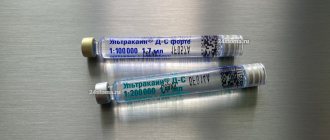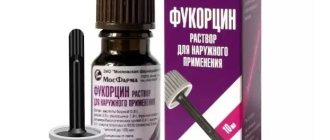238
Scandonest is an anesthetic for pain relief during dental treatment (therapeutic, surgical).
The drug is used by adults and children of all ages. The dosage is calculated by the doctor taking into account the medical history and body weight (in the child).
Drug review
The main active ingredient is mepivacaine hydrochloride. A distinctive feature of the regional anesthetic is its immediate action relative to other groups of anesthetics (procaine, novocaine).
Local insensitivity to pain begins to appear the first minute after administration of the drug, the effect is rapid and long-lasting.
Additional components in the solution:
- sodium hydroxide – a buffering agent to give the desired pH level;
- sodium chloride is the basis for the production of solutions for parenteral administration;
- water for injections.
Scandonest in dental practice is used for infiltration (blockade of receptors and small nerves) and conduction (blockade of nerve plexuses, trunks) anesthesia.
The mechanism of action is blocking stress-dependent sodium channels of nerve membranes, inhibiting the conduction of nerve impulses of sensory, motor, and autonomic nerve fibers.
Initially, the substance penetrates the nerve membrane into the nerve cell itself. There it enters into a chemical bond with a proton, forming an active form, and begins to act.
The substance is quickly distributed in soft tissues. It breaks down into metabolites in the liver and is excreted by the kidneys with urine, intestines with bile, 10% unchanged.
Duration of anesthesia:
- for infiltration use in the area of the pulp of the upper jaw - 25-35 minutes;
- after injection into the mandibular alveolar nerve – 40-50 minutes;
- anesthesia of soft tissues on both jaws lasts 1.5-2.5 hours.
What are Turner's teeth and is the pathology curable?
Come here if you are interested in the effectiveness of using ultrasound in endodontics.
At this address https://www.vash-dentist.ru/lechenie/zubyi/schitayutsya-intaktnyimi.html we will consider the indications for opening the cavity of an intact tooth.
Pharmacokinetics
Injected into the oral cavity through local infiltration anesthesia, mepivacaine reaches its peak concentration in the blood approximately 30 minutes after the injection. The half-life is long and is approximately 90 minutes.
Mepivacaine is metabolized quite quickly and only 5-10% is excreted unchanged in the urine. Having an amide structure, mepivacaine is not metabolized by plasma esterases. The liver is the main site of its metabolism. Any liver pathology (cirrhosis, hepatitis) leads to a general accumulation of mepivacaine.
Use for children
Scandonest is used in pediatric dentistry from the age of 4 years. One of the recommendations for using this drug in children is that it does not contain preservatives.
This minimizes the risk of developing a polyvalent allergy during short-term interventions - removal of a baby tooth, treatment of uncomplicated caries, vital pulpotomy (removal of coronal pulp during inflammation) on temporary or permanent teeth. Anesthesia with a solution is indicated for plastic surgery of the frenulum of the tongue using a laser technique.
When using local anesthetics of different groups and Scandonest, a child may experience additive toxicity - total toxicity when several drugs are combined.
This effect is not diagnosed in adults. Although the concentration of the substance in plasma does not increase, this fact should be taken into account when administering local anesthesia in children.
Contraindications
- Known allergy to local anesthetic solutions belonging to the same chemical group.
Contraindications associated with the use of mepivacaine hydrochloride:
- severe myasthenia gravis;
- low levels of cholinesterases in plasma;
- serious liver dysfunction: cirrhosis, hereditary or acquired porphyria.
Attention athletes! Scandonest contains an active substance that may cause a positive reaction during anti-doping control.
Impact on the ability to drive vehicles or use machinery.
There were no effects of SCANDONEST 3% on vigilance, reaction time to visual stimulation or motor coordination in the studies.
Main incompatibilities: antiarrhythmic drugs (tocainide, etc.).
Indications and restrictions
Indications for the use of Scandonest for local anesthesia:
- treatment of superficial, medium, deep, complicated, generalized caries;
- removal of the nerve, filling of passable and impassable canals;
- simple removal of teeth, including milk teeth, 8th;
- atypical removal;
- opening of periodontal abscess, periostitis;
- resection of the root apex;
- hemisection – removal of one root from a multi-rooted tooth;
- coronary-radicular separation – dissection of the crown and trunk of the tooth for further treatment;
- treatment of periodontitis, alveolitis;
- excision of hypertrophied papillae;
- plastic surgery of the frenulum of the lip and tongue;
- installing or removing a pin;
- preparation of the cavity, treatment of the tooth stump before installing an orthopedic structure, aesthetic restoration.
The anesthetic is not used for patients with high hypersensitivity to the active substance.
Absolute contraindications are severe hypertension, acute heart failure, hereditary metabolic pathology.
Scandonest should not be used by people with a history of malignant hyperthermia - a life-threatening condition that develops after general anesthesia (oxidation of the body, continuous muscle spasm, high temperature).
Local anesthesia is not recommended for drug-uncontrolled epilepsy.
Dosage regimen and side effects
The drug is used exclusively in the field of dentistry. Adults are administered from 1 to 4 ml, depending on the complexity and duration of the upcoming treatment.
In children over 4 years of age and weighing 20-30 kg, the analgesic effect occurs with the introduction of 0.25-1 ml; with a weight of 30-40 kg, 0.5-2 ml will be needed. On average, the dosage is calculated using the following formula: 0.75 mg of active substance per 1 kg of weight, which equals 0.025 ml/kg.
An elderly person remains at risk of high concentrations of Scandonest in plasma due to slow metabolic processes, low distribution of the anesthetic, and general weakening of the body.
In these cases, it is recommended to reduce the dosage and not perform repeated injections (additional anesthesia). A dose reduction is mandatory in people with chronic heart and vascular diseases (angina pectoris, arteriosclerosis).
The maximum single dose for healthy adults is 4 mg/kg, which corresponds to 0.133 ml/kg. This means that a person weighing 70 kg is allowed a single injection of 300 mg of mepivacaine (10 ml of Scandonest).
For a child over 4 years of age, the required volume is calculated based on body weight, age, and duration of therapeutic or surgical manipulation. The equivalent of 3 mg/kg or 0.1 ml/kg should not be exceeded.
Attention! The main reasons for possible side effects are excessive dosage, slow metabolic processes, rapid absorption of the solution, unintentional injection into the lumen of a blood vessel.
Severe complications of local anesthesia develop extremely rarely and manifest themselves in the nervous system:
- neuralgic pain, damage to part of the peripheral nerve, root, plexus;
- paresthesia – burning, tingling, tingling, numbness, sensation of heat or cold, itching, malfunction of taste buds, metallic taste in the mouth;
- depression or stimulation of the nervous system;
- headache, dizziness, impaired consciousness, drowsiness;
- muscle tremors, partial paralysis, drooping eyelids, fainting, respiratory arrest;
- disorientation in space, impaired coordination, diction;
- with deep depression of the central nervous system - loss of consciousness, convulsions, coma.
The drug can depress the activity of the cardiovascular system - slow down or increase heart rate, provoke arrhythmia, increased blood pressure, and atrial fibrillation.
In severe cases, the conduction of the heart muscle is disrupted, acute cardiovascular failure develops, which can provoke cardiac arrest. This condition is preceded by increased sweating, dizziness, severe weakness, and changes in heart rate.
Other possible side effects:
- slow or frequent movement of the chest , respiratory depression until it stops for 1-2 minutes, hoarseness in the voice, decreased oxygen and increased carbon dioxide in the body;
- allergic reactions - itching, redness, peeling of the skin, rashes, urticaria, swelling of the tongue, mucous membranes of the upper respiratory system, face, increased body temperature, bronchospasm;
- nausea, single vomiting not associated with food intake, stomatitis, gingivitis, glossitis (inflammation of the tongue);
- muscle twitching, chills , swelling at the site of anesthetic injection, chest pain, weakness, fatigue, fever.
Scandonest
Manufacturer: SEPTODONT (France)
solution for injection 3%: 1.8 ml cartridges 10, 20, 30, 40, 50, 60, 80, 100 or 120 pcs. Reg. No.: P No. 012996/01
Clinical and pharmacological group:
Local anesthetic for use in dentistry
Release form, composition and packaging
| Solution for injection 3% | 1 ml |
| mepivacaine hydrochloride | 30 mg |
1.8 ml - cartridges (10) - cardboard packs. 1.8 ml - cartridges (10) - contour cell packaging (2) - cardboard packs. 1.8 ml - cartridges (10) - contour cell packaging (3) - cardboard packs. 1.8 ml - cartridges (10) - contour cell packaging (4) - cardboard packs. 1.8 ml - cartridges (10) - contour cell packaging (5) - cardboard packs. 1.8 ml - cartridges (20) - contour cell packaging (6) - cardboard packs. 1.8 ml - cartridges (20) - contour cell packaging (2) - cardboard packs. 1.8 ml - cartridges (20) - contour cell packaging (3) - cardboard packs. 1.8 ml - cartridges (20) - contour cell packaging (4) - cardboard packs. 1.8 ml - cartridges (20) - contour cell packaging (5) - cardboard packs. 1.8 ml - cartridges (10) - contour cell packaging (6) - cardboard packs.
Description of the active components of the drug "Mepivacaine"
pharmachologic effect
A local anesthetic, the mechanism of action of which is associated with the stabilization of cell membranes. Causes all types of local anesthesia: terminal, infiltration, conduction. Has a fast and strong effect.
Indications
For local anesthesia during various therapeutic and surgical interventions in the oral cavity (lubrication of mucous membranes during tracheal intubation, bronchoesophagoscopy, tonsillectomy; in dentistry).
Dosage regimen
The amount of solution and the total dose depend on the type of anesthesia and the nature of the surgical intervention or manipulation. The average single dose is 1.3 ml; if necessary, the dose can be increased.
Maximum daily doses:
for adults and children weighing more than 30 kg - 5.4 ml; for children weighing 20-30 kg - 3.6 ml; for children weighing less than 20 kg - 1.8 ml.
Side effect
Maybe:
(especially if the dose is exceeded or with accidental intravascular administration) euphoria, depression, speech disorders, swallowing, vision, convulsions, respiratory depression, coma, bradycardia, arterial hypotension; allergic reactions (urticaria, Quincke's edema).
Contraindications
Hypersensitivity to amide-type local anesthetics and alkyl-4-hydroxybenzoates (parabens).
Pregnancy and lactation
During pregnancy, the use of mepivacaine is possible only under strict indications.
Use in old age
Use with caution in elderly patients.
special instructions
Use with caution in elderly patients.
Drug interactions
With the simultaneous use of mepivacaine with beta-blockers, calcium channel blockers and other antiarrhythmic drugs, the inhibitory effect on myocardial conductivity and contractility increases.
Drug interactions
With the simultaneous use of mepivacaine with beta-blockers, calcium channel blockers and other antiarrhythmic drugs, the inhibitory effect on myocardial conductivity and contractility increases.
Guidance and Warnings
To carry out infiltration or conduction anesthesia, a cartridge syringe with a standard carpule (reservoir with solution) with a rubber piston.
Before use, the medicinal product should be visually assessed for the presence of flakes, sediment, foreign particles, discoloration, and damage to the container. If the cartridge has defects, it should not be used.
Before starting anesthesia, the rubber stopper is treated with an antiseptic (alcohol); the bottle should not be placed in a disinfectant solution. The anesthetic is not mixed with any other drug.
To avoid puncture of the vessel, you need to carefully perform an aspiration test in several planes (rotating the needle 180°). But this does not exclude unintentional or undetected intravascular puncture.
Accidentally puncturing a nerve will cause the medication to spread throughout the nerve. If the patient experiences sharp pain or a sensation of electric shock during the injection, the needle should be slightly removed. This will help avoid damage to nerve fibers.
The rate of administration of Scandonest should not exceed 0.5 ml in 15 seconds; a full cartridge is administered within a minute.
In most cases, negative systemic reactions when entering a vessel or nerve can be avoided thanks to the correct injection technique. After aspiration, slowly inject 0.1-0.2 ml of solution, then slowly inject the remainder - no earlier than after 20-30 seconds.
Important! Capsules with any remaining unused anesthetic must be disposed of. It is prohibited to use them on other patients.
Causes of development of radiation caries and tactics of its treatment.
In this publication, we will look at the types of dental dams for deep caries.
Here https://www.vash-dentist.ru/lechenie/zubyi/trepanatsiya-eta-protsedura.html we’ll talk about the technique of trepanation of the dental cavity in modern dentistry.
Drug interactions
When using Scandonest and Cimetidine (a drug used to treat peptic ulcers), the level of anesthetic in the blood increases. An anesthetic in combination with drugs for hypertension, arrhythmia, and myocardial infarction accelerates the contraction of the heart muscle.
Sedatives that depress the central nervous system require a reduction in the dose of pain medication, since Scandonest also depresses the central nervous system.
In patients taking anticoagulants (blood thinners), the risk of bleeding, including internal bleeding, increases.
With the simultaneous use of narcotic analgesics and general anesthesia (ether, chloroform), toxic synergism may develop.
Release form and price
Scandonest is available in transparent glass cartridges of 1.8 ml. At one end, the carpules are sealed with a rubber stopper and an aluminum cap, at the other - with a rubber piston plug.
| Number of cartridges | Price per package in rub. |
| 1.8 ml (10), 1 blister pack | 425 |
| 1.8 ml (10), 2 blister packs | 796 |
| 1.8 ml (10), 3 blister packs | 1470 |
| 1.8 ml (10), 4 blister packs | 2120 |
| 1.8 ml (10), 5 blister packs | 3750 |
Dosage and instructions Scandonest
Adults For ongoing interventions:
- Use 1-3 cartridges of SCANDONESTA 3% WITHOUT VASOCONTRACTOR COMPONENT, 1.8 ml per 1 intervention, depending on the area that needs to be anesthetized and the injection technique.
- In rare cases, the operation is repeated within one week on the same patient. Taking into account these 2 points, as well as the concentrations of active substances in 1 cartridge, data for which are reported by the manufacturer, the maximum doses of active substances that can be used during one visit will be as follows: - mepivacaine hydrochloride; - 1.8 ml cartridges 3x54,000 mg = 162 mg, which corresponds to 2.7 mg of mepivacaine hydrochloride per 1 kg of weight for a patient whose weight is 60 kg.
Under no circumstances should the dose exceed 300 mg per visit.
Children
The injected dose of Scandonest is determined depending on the age of the child and the degree of complexity of the intervention. The child's weight should be taken into account. The average dose is 0.025 ml of anesthetic solution per 1 kg of weight. The total dose should not exceed 1 cartridge per visit. The maximum dose of mepivacaine hydrochloride in mg that can be used in a child will be as follows: Child's weight (in kg) x 1.33.
Analogs
An absolute analogue based on mepivacaine is Sandinibsa (manufacturer – Spain). The effect of the substance begins in 2-3 minutes and lasts 45 minutes.
It does not have a vasoconstrictor effect, so it can be used in patients with chronic diseases of the cardiovascular system.
Mepivastezin – based on mepavacaine (manufacturer – Palestine). The anesthetic can be used in children weighing less than 20 kg, and the maximum dosage should not exceed 1.8 ml.
Artifrine is a solution based on articaine and epinephrine (a vasoconstrictor). It should not be administered to people with diseases of the hematopoietic system, ventricular tachycardia, hypoxia, and angle-closure glaucoma.
Pharmacological properties
Mepivacaine hydrochloride is an amide-type local anesthetic. We are talking about 1M-methylpipecolic acid dimethylanilide hydrochloride or mepivacaine hydrochloride. When given by injection near sensory nerve branches, mepivacaine reversibly blocks the passage of painful nerve sensations.
Unlike most active substances in anesthetic solutions, which have, among other things, vasodilator properties, mepivacaine has a vasoconstrictor effect, which allows in many cases the use of a solution with a reduced content of the vasoconstrictor component.
Anesthesia occurs quickly (in 2-3 minutes). The anesthesia is deep and its effect lasts from 20 to 40 minutes.
Reviews
On the forums you can find different opinions about the effectiveness of Scandonest. If you have had experience with dental treatment using the drug, share your impressions, tell us how comfortable the manipulations were, how quickly you recovered from anesthesia.
If you find an error, please select a piece of text and press Ctrl+Enter.
Tags: anesthesia, toothache
Did you like the article? stay tuned
Previous article
Unique and effective 3d Smile mouth guards from Russian developers
Next article
Expansion of the upper jaw in early mixed dentition using the Marco Ross apparatus





